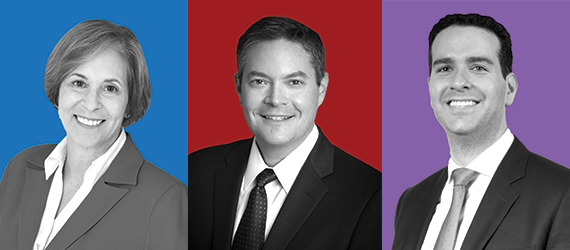Trending
 "Financially devastating": Receiver takes over embattled Pembroke Pines condo complex
"Financially devastating": Receiver takes over embattled Pembroke Pines condo complex Pinnacle Bank buys back Fort Worth office tower for $12 per sf
Pinnacle Bank buys back Fort Worth office tower for $12 per sf  Blackstone sells huge industrial portfolio in NYC, New Jersey
Blackstone sells huge industrial portfolio in NYC, New Jersey “Multifamily is in the crosshairs”: Execs talk distress, opportunities at Milken conference
“Multifamily is in the crosshairs”: Execs talk distress, opportunities at Milken conferenceThe Financial District doubles down on retail
An influx of residents, big-spending tourists</br> and office workers has the financial hub hopeful about its retail future

Westfield’s World Trade Center complex may have gotten off to a wobbly start, but Lower Manhattan’s retail scene appears to finally be finding its footing. Brookfield Place’s $250 million revamp brought in luxury retailers like Hermes and Burberry, as well as a food hall that quickly became a favorite of local families. Westfield World Trade Center is now fully leased, according to a spokesperson, and Pier 17’s new 300,000-square-foot retail space is slated to open next year. Meanwhile, the area’s demographics have changed — decades of residential conversions and the recent wave of construction have established a critical mass of younger, well-to-do residents. The population has doubled since 2000, and a third of families in the area earn $200,000 or more, according to the New York State Comptroller. And financial services, once the district’s defining industry, now accounts for only 34 percent of total jobs in the area, compared to 56 percent in 2000. With that new demographic in mind, Whole Foods is set to open a new store at One Wall Street in 2018. “It’s a big deal,” said Susan Kurland, executive vice president and co-head of global retail services at Savills Studley. And it’s not just families and office workers who are driving the retail scene — the district has seen a huge influx of tourists, with the WTC memorial bringing 14 million visitors to the area annually. The greater diversity Downtown has extended the shopping day, broadened demand, and created a unique retail mix distinct from Soho or Tribeca, according to industry observers. “FiDi stands on its own,” said Lee Block, executive vice president at Winick Realty Group. “It has its own daytime workforce population, its own residential population, and retail coming in to serve that population.” For more on how retail in the area is evolving, we turn to our panel of experts.
Michael Goldban
Senior vice president of retail leasing, Brookfield Properties
Between Westfield and Brookfield Place, should there be concerns about the luxury retail market becoming oversaturated?
Our projects are both unique and complementary, and our sales are strong. With both projects now online, awareness is up and foot traffic at Brookfield Place has sharply increased after the opening of the Westfield project.
With the much-talked-about struggles in the retail industry and the dominance of e-tailers, do you see rents softening in the FiDi?
Brookfield Place, with our free Arts Brookfield and community and experiential programming, has become a great complement to online retail. We don’t foresee any softening — in fact, we see physical and online growth going hand in hand. We are also now partnering and launching new technology platforms to complement our retailers and eateries, allowing for on-demand food ordering and tailored concierge offerings.
What kinds of shoppers are you targeting?
Office tenants of Brookfield Place — a workforce of about 50,000 — is increasingly eager to blend work and play. In response, we’ve implemented a placemaking approach, where office buildings are combined with retail amenities, top-tier dining options and year-round, curated arts and events in the Winter Garden and beside the marina.
What projects do you see as the biggest potential game changers for FiDi retail?
Saks Fifth Avenue opening at Brookfield Place. The addition of a luxury department store has helped to turn the area into a global hub for fashion.
Lon Rubackin
Senior vice president, CBRE retail services group
How does the retail district differ from other Downtown areas like Tribeca and Soho?
FiDi is larger geographically. From Battery Park and Brookfield Place all the way to South Street Seaport, that’s bigger than Soho and bigger than Madison Avenue’s retail corridor. FiDi is just going to have more of everything, and it will be able to have pockets with different retail flavors.
What kinds of shoppers are FiDi retailers targeting?
There is no one answer. At Century 21, the anchor of retailing Downtown for almost a generation, the majority of the customers are tourists. Meanwhile, if you go to the stores down John Street and Liberty Street, they’re targeting the office workers and residential folks at night. Downtown is getting better all the time because it’s not relying on just one category: just tourists, just residents or just office workers.
Given the most recent lawsuit at Westfield WTC — the fifth — do you think retailers are getting cold feet? Is there enough demand to fill the mall?
Generally speaking, if a tenant backs out of a lease, that’s a major statement. However, nine times out of 10, it’s because the retailer is having financial problems. When a project is being constructed and won’t be delivered until some time in the future, a retailer’s fortunes can go up and down dramatically. As everyone knows, this project was delayed for a long time. For the time [retailers] signed the lease to the time they were required to open was likely two or three years. It’s easy to go out of fashion, and it can happen in a matter of months. As the center matures, retailers will have better feelings about going in and committing.
Between Westfield and Brookfield Place, is luxury retail market becoming oversaturated?
To me, Downtown is one of the most exciting places for retail in the entire city. You have a tremendous mix of high-end residential, an extremely strong tourist presence, and now Class A office. You never saw all three of those components at one time Downtown before. There is still room, not for everybody, but certainly for the best in class, and by that I don’t mean the most expensive.
Last spring, REBNY reported that asking rents for ground floor retail in the FiDi corridor increased 39 percent, to $326 per square foot, from the year-earlier period. What was behind the huge price jump and where do you see rents going?
The jump can be attributed to the overall positive events — office, residential and retail exploding. The people living there are all high-income earners, which is why BMW, Tiffany and Canali first went down there, and more and more companies are following. If you look at what $300 a square foot buys you in other parts of the city, retail rents Downtown are cheaper compared to areas like Madison Avenue, which can run up to $2,000 a square foot, or Times Square, where asking is $2,000 a square foot, or Meatpacking, which is asking $500, $600 or $700 a square foot. Even Hudson Yards, which isn’t built or open yet, is asking rents in the $400 to $500 range.
Can you talk about what impact the scheduled 2018 opening of Whole Foods at One Wall Street will have on the area?
It will have a huge impact for the 60,000 people living there. In the past, Whole Foods has tended to situate its stores in New York pretty far away from each other. But they have another store in Tribeca, at 270 Greenwich Street. The fact that they are willing to place these two stores so close together is telling you something about their confidence in the market. Add Whole Foods to Eataly a few blocks away [at 4 World Trade Center] and you’re starting to put together a best-in-class mix.
Robin Abrams
Vice chairman and principal, the Lansco Corporation
How do you explain the pullback from tenants at Westfield?
Some of the tenants that were reported to have backed out, like Bebe, True Religion, Dune and Fika, have changing business models and are not doing any new stores in New York City, or perhaps anywhere, as they rationalize their retail portfolios. Others may have been put off by the rent, the construction costs and the challenges of building a store at the site, with union labor and other constraints.
Should there be concerns about the luxury retail market becoming oversaturated?
Luxury sales are still relatively strong, and are fueled in part by tourists. Brookfield Place will be more of a destination because it consists of a more upscale co-tenancy. WTC has a tenant mix that will appeal to a larger audience: tourists, office workers and area residents. The population Downtown consists of many professionals working in the financial sector who shop luxury and fashion. There are a slew of people living and/or working Downtown that do not shop Uptown, but they will still shop for and buy luxury and fashion items, whether that’s jewelry, shoes or apparel.
What was behind the huge price jump in retail asking rents?
The price jump was due to high-profile retail space coming available on Broadway. Earlier reports included space that was more difficult, with less visibility or narrow layouts. Now there are some great options available and the pricing reflects that.
What impact will the scheduled 2018 opening of Whole Foods at One Wall Street have on the area?
Traditionally, there was not enough of a residential base for a large supermarket to lease a big location and support the rent. Whole Foods had begun opening smaller locations in urban settings that cater to a mixed population, including office workers. The company is now more willing to be creative and flexible with regard to layout, operating, loading and deliveries than when they first entered the NYC market.
What about the opening of the new Pier 17, slated for 2017?
Putting fabulous food options there is a magnificent idea. Not unlike Related’s Time Warner Center or Hudson Yards, the restaurant options will set the tone for the rest of the retail project. People will go there to dine, with valet drop-off. And let’s not forget this is on the water with water views in three directions. However, keeping people in the vicinity will be the challenge.
What are some of the most surprising trends you’ve observed in the retail scene?
The food hall concept — the upscale answer to the food court — which exploded and seems to have no end in sight. This trend has taken [away] some of the opportunities for sit-down restaurants to flourish in the Financial District.
Lee Block
Executive vice president, Winick Realty Group
Between Westfield and Brookfield Place, should there be concerns about the luxury retail market becoming oversaturated?
I don’t think there is an oversaturation. The demographics Downtown support what these retailers typically look for: extremely high population density, very high average incomes for households, as well as well above average workers’ incomes. From Century 21 to Tiffany and Hermes, there is a place for everyone to prosper in Lower Manhattan.
What was behind the huge price jump that REBNY reported last spring, and where do you see rents going six months and a year from now?
A lot of new prime, prime space has come on the market lately, and that has affected average pricing. And it wouldn’t surprise me if prices kept going up in the best corridors Downtown as space is absorbed and there is less supply. The corner of Wall Street and Broad Street acts as a pseudo-Times Square for Lower Manhattan. The WTC is a very busy area of Downtown as well. Meanwhile, secondary cross streets, like Fulton Street, John Street, Maiden Lane, are incredibly strong compared to years back. Retailers are leaving their spaces and being replaced with newer, exciting, unique types of retailers.
How could FiDi’s retail landscape be improved?
Dinner options in the neighborhood are still extremely limited.
What challenges remain for bringing in basic retail amenities like supermarkets?
The neighborhood has been serviced, just under-serviced. The infrastructure Downtown has been a challenge for any full-service supermarket to enter the market. The buildings — many of which are landmarked — on older, narrow streets were not built for that kind of an operation.
Susan Kurland
Executive vice president and co-head of global retail services, Savills Studley
Between Westfield and Brookfield Place, should there be concerns about the luxury retail market becoming oversaturated? How has the downturn in the financial industry affected foot traffic and sales?
Downtown Manhattan gets an inordinate amount of traffic. I don’t think feet on the street is a problem at all. I also don’t think there is too much luxury. I don’t think people will specifically go down there, but if they are living there, why would they need to go up Madison Avenue or 57th Street to shop? It’s a matter of convenience.
How does the retail district differ from other Downtown areas like Tribeca and Soho?
Soho is a lot a lot of brands. Every brand you can think of is there. Tribeca is getting more retail tenants, but I don’t personally consider Tribeca, with its quiet demeanor, to be a shopping environment.
In June, the City Council approved plans to rezone the pedestrian arcades at the base of buildings on Water Street to permit enclosed retail venues. What kind of retail do you see coming there?
Water Street can be successful, except in the cold months. The wind off the water makes it colder around there, which makes me not 100 percent convinced about it. Part of the reason that the World Trade Center and Brookfield Place will be successful is because of the convergence of all these buildings underground. In the cold weather, you don’t have to go outside.
David C. Berkey
Executive vice president, L&L Holding Company
L&L owns two buildings in FiDi. What incentives, if any, are you offering brokers or tenants to fill out the retail?
In our two buildings [195 Broadway and 222 Broadway], we have not had to do anything in terms of incentives and have gotten rents well over $500 per square foot. We recently finished a nearly 10-year project bringing retail space to the landmarked lobby of 195 Broadway and secured leases with Nobu and Anthropologie years in advance of the project’s completion. If you have great space in a great location, incentives are not necessary.
Do you think there’s enough demand to fill the WTC mall — and how long will it take?
Every retail project the world over needs time to get the mix of tenants right, but at the end of the day, the one thing every successful shopping center must have is pedestrian traffic, and Westfield has no shortage of that. I have no doubt that in time it will prove to be another feather in the cap of Lower Manhattan.
How has the arrival of Condé Nast changed the character of FiDi and its retail makeup?
Condé has always been a trendsetter in terms of where they have had their corporate offices. Their being at the forefront of culture and good taste is built into their corporate DNA.
What are some of the most surprising trends you’ve observed in the retail scene?
While it’s not at all surprising, the impact of the Internet has been by far the biggest challenge faced by traditional retailers. It takes something special to get people out of their living rooms, and food is a major component of that.
Jessica Lappin
President, Alliance for Downtown New York
How does the retail district differ from other Downtown areas like Tribeca and Soho?
Something that sets us apart is our unique mix of historic and modern spaces. We have restaurants and shops in buildings like the Beekman’s Temple Court and the Woolworth Building, but also in the WTC and Brookfield Place.
As you’ve noted before, the area still lacks sufficient basic retail amenities like supermarkets. What are the challenges for bringing in new retail?
That’s changing, and it’s changing fast. Currently, there are seven supermarkets, seven gourmet markets, including Le District and Eataly, and six Greenmarkets. The addition of the Whole Foods at One Wall Street and Dean and DeLuca at 40 Wall Street will only add to that. In October, Tribeca welcomed Target’s first flexible-format store in Manhattan, at 255 Greenwich Street — a move that was made in large part to serve the number of families in the area. In terms of challenges, we have narrow streets — some are cobblestone — which can be hard for stores that need truck deliveries. Landlords and tenants have to be creative to deal with tougher logistics than you would have in the suburbs.
Do you think there’s enough demand to fill the WTC mall?
Lease volatility at the beginning of any shopping complex is not uncommon, and having access from 13 subway lines, the PATH trains and ferry terminals via Fulton Center is a huge locational advantage that currently draws 300,000 travelers each day.
What kind of retail do you see coming to the recently rezoned pedestrian arcades on Water Street, and how long will it take for it to become a lively retail corridor?
The retail opportunities included in the zoning are geared toward small businesses, typically 6,000 square feet or less. We want community-oriented retail that will add character and value for those who live and work here, especially on nights and weekends. This won’t happen overnight. But over time, it will incentivize landlords to make significant investments in the public plazas and to their buildings.
What do you see driving the huge increase in retail rents?
The potential of the market — we’ve had huge residential and workforce growth over the past few years. The neighborhood is well on its way to becoming a regional shopping destination. Recently, we’ve seen Zara expand their space, and Urban Outfitters has committed to bringing in its sister store, Anthropologie. We have a low storefront vacancy, and we attribute that in part to landlords who understand how to properly set rents and adapt their spaces to accommodate the needs of stores and restaurants.
How has the arrival of Condé Nast changed the character of FiDi and its retail makeup?
Condé Nast is just one of a number of new companies that have migrated Downtown. Over the past several years, we’ve seen a diversification in jobs with a noticeable jump in creative and tech opportunities — the number of TAMI companies stands at over 800 today — including publishing titans like Time Inc. and HarperCollins, new web forces like Vox Media, Refinery 29 and the XO Group, media and technology agencies GroupM and Mediamath, and advertising firm Droga5. Hudson’s Bay Company, Gucci, Hugo Boss and Revlon lead the pack of new companies specializing in fashion and beauty. These newcomers are bringing more buying power with new tastes and retail habits.
